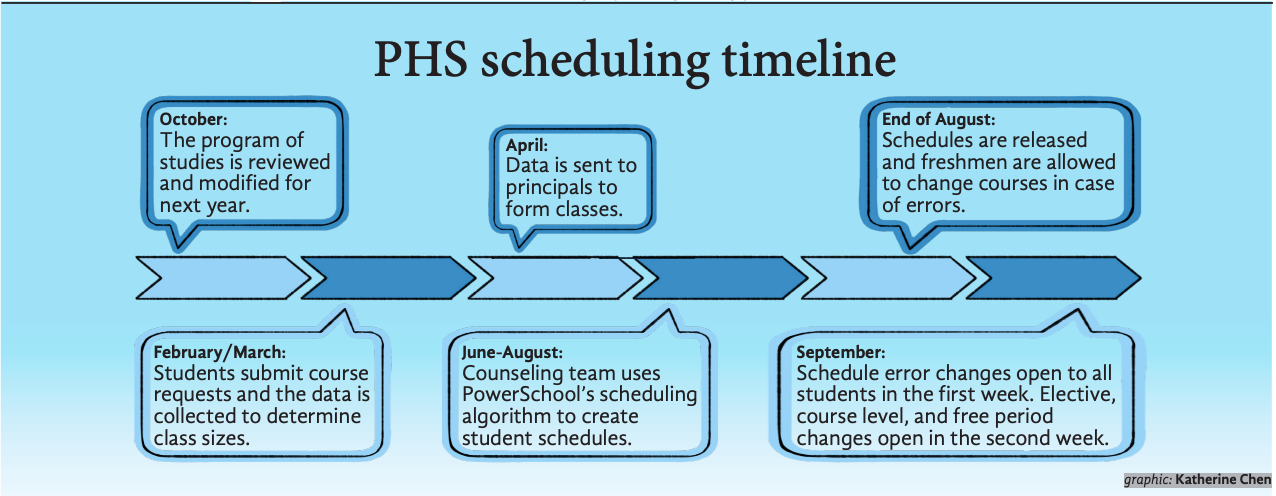Tower Investigates: How does PHS schedule classes?
September, 2024
Even before the school year begins, frustration abounds over scheduling. Emails and students fly into the counseling office during the first few weeks of school, all scrambling to switch in and out of classes.
Student scheduling ensures that students have access to the courses they need for graduation, while maintaining balanced class sizes. An effective system helps in optimizing the use of school resources, aligning teacher availability with student needs, and accommodating individual student requests.
At PHS, it involves a wide range of staff, including the administrative team, which consists of the principal, assistant principals, and the counseling department.
The process begins with reviewing and modifying the previous year’s Program of Studies. The curriculum office, the School Board, Principal Cecilia Birge, and John McMichael, supervisor of the counseling department, collaborate on this task starting as early as October of the previous year.
“October is the time when we begin to review every single course and say: Is this outdated? Is there a new thing that we can add in? Do we need to hire a new teacher? Do we have the expertise? Maybe some teachers have a certain passion that they want to develop in a certain course. So there’s a lot of reshuffling, refining and redesigning,” Birge said.
Afterward, beginning in February and March of the previous year, students and families submit their course requests. This data is collected and analyzed to determine the number of course sections needed.
At the end of April, the supervisors send the data to Birge and the assistant principals, who work to create all the students’ schedules. After students and parents finalize their requests in June, the counseling team enters the data into Powerschool’s scheduling algorithm throughout the summer, fitting students’ requests into the master schedule. For this year’s scheduling cycle, Assistant Principal Lauren Freedman served as the “master scheduler,” managing staff scheduling and assigning teachers to courses and classrooms.
Throughout these few months, while administrators work more on building a master schedule, counselors meet with students to help them make course requests for the next school year.
“We want to make sure that every kid makes informed decisions. We’re also tracking each student’s graduation progress and helping them think about post-high school as well,” said counselor Meghan Brennan.
After schedules are finalized and released to students and families towards the end of August, the counselors revise any errors or course changes, beginning in the first week of school.
“We collect all the schedule change requests on a Google Form. We do that to address all requests in a fair and equitable manner,” Brennan said.
In the time between when schedules are released and the first day of school, scheduling changes are restricted exclusively to freshmen with scheduling errors. Then, in the first week of school, all other grade levels are also permitted to schedule changes in the case of errors.
“For the first few days of school, we don’t allow schedule changes unless there is an error. And there’s a few reasons for that, one of which is so that students will try out the class. A lot of times, students request a class change, they spend three days in the class, and then they realize they want to stick with it,” Brennan said.
Finally, during the second week of school, elective, course level, and free period change requests are granted. These are often more complex than finding a simple swap between periods through friends or scheduling tools such as Saturn, an application that allows students to visualize their schedules.
“What Saturn doesn’t know is [there are class] caps. You might say, I just want to flip and move in, but what if they’re all filled to the brim?” McMichael said.
In addition, some course requests might be irreconcilable.
“You might request eight classes, but two of them are [what] we call singletons. There’s only one period of each and they’re at the same time. You can’t be in two places at once, so you’ll have a hole in your schedule and end up with a free,” McMichael said. In order to allow for more scheduling flexibility this year, P.E. and science classes were uncoupled. Previously, the two classes were linked to allow for the P.E. class to be replaced by a free period and lab period once every schedule cycle.
“There were less issues this year because there [were] more variations that the computer could utilize,” Brennan said. Brennan emphasizes the importance of prioritizing mental health, maintaining balance, and planning ahead while navigating this process.
“We also want to think about what [students] want to do post high school, so that they’re setting themselves up for success in taking classes that will help them reach those goals,” Brennan said.